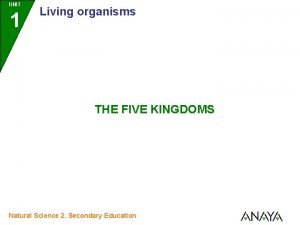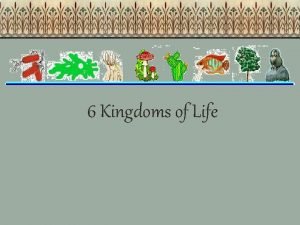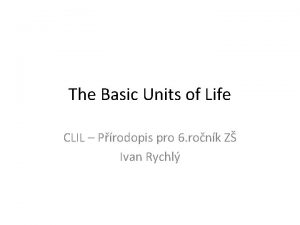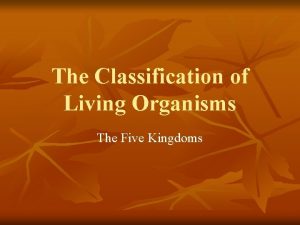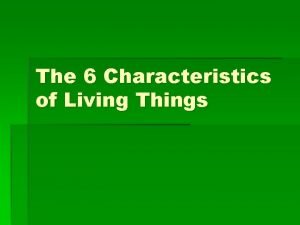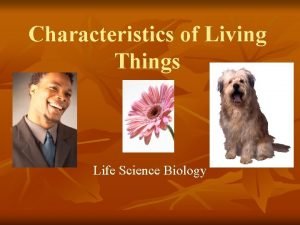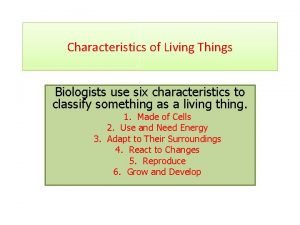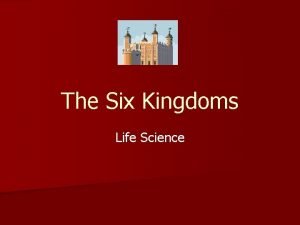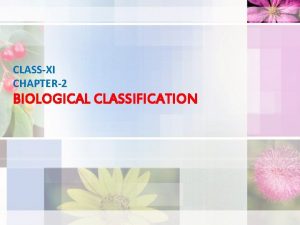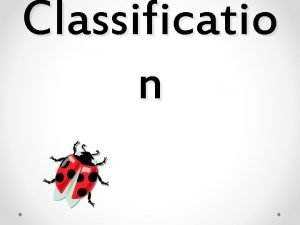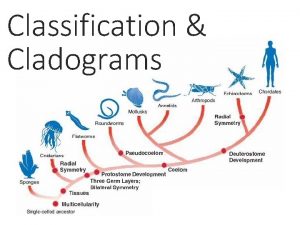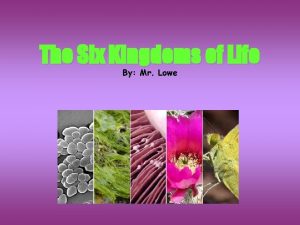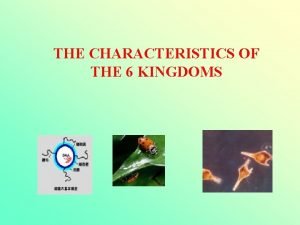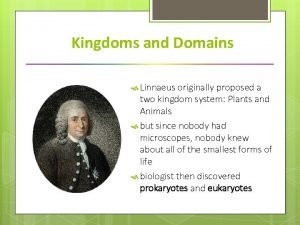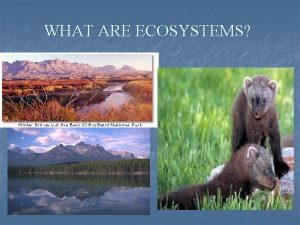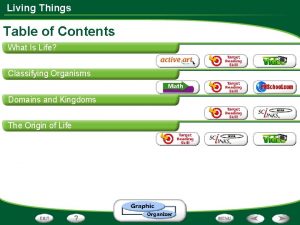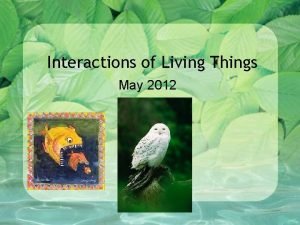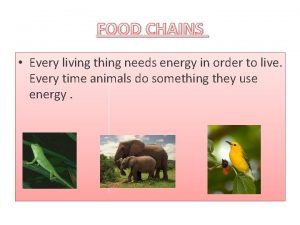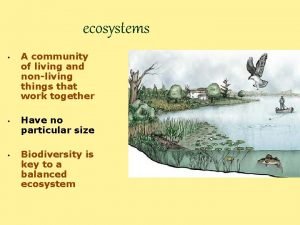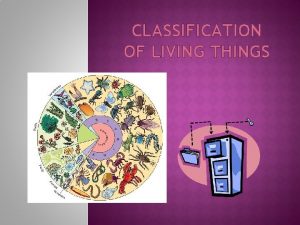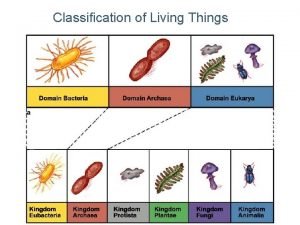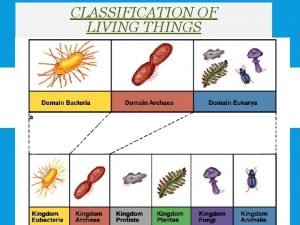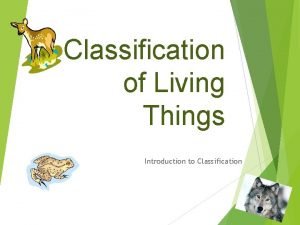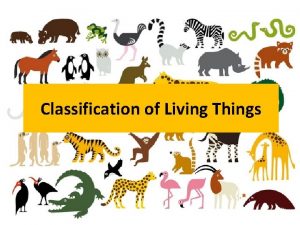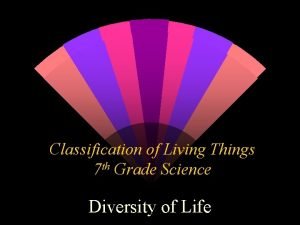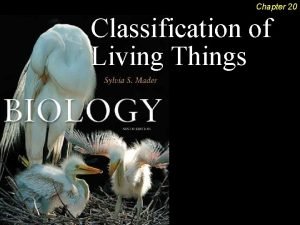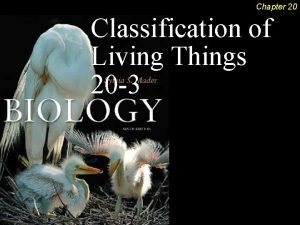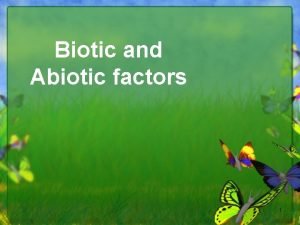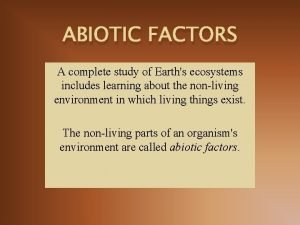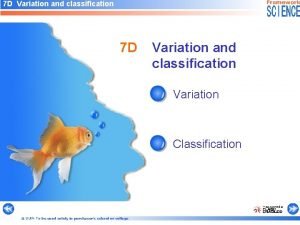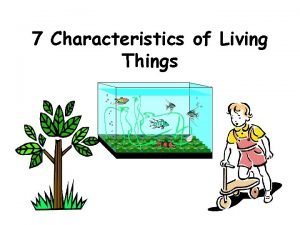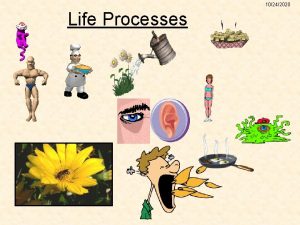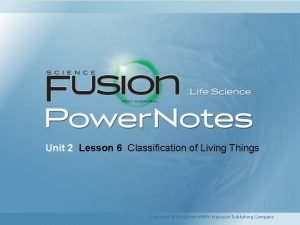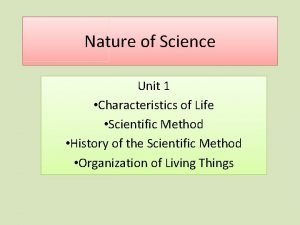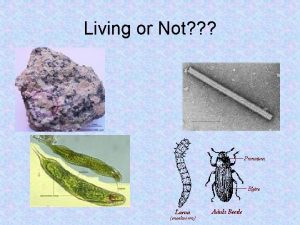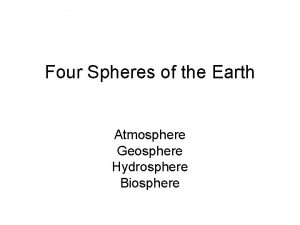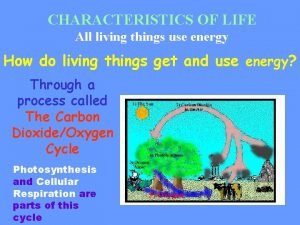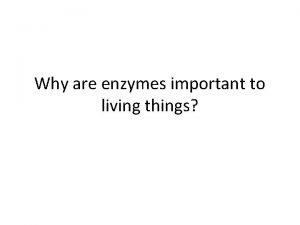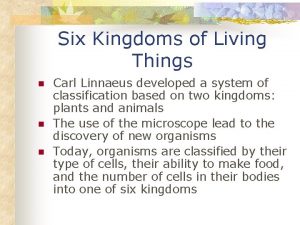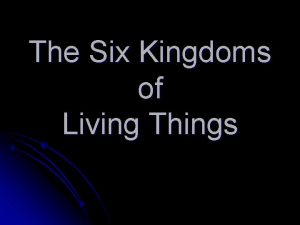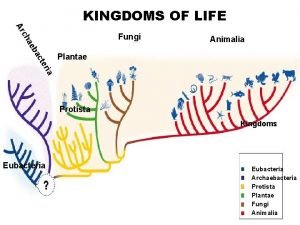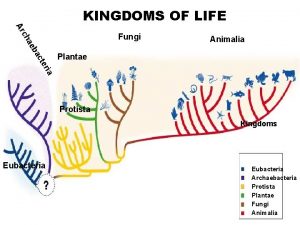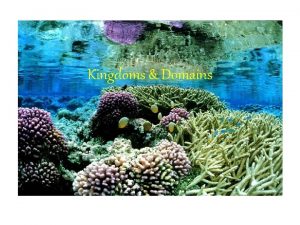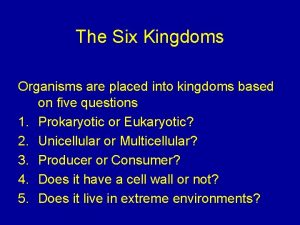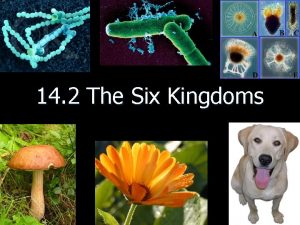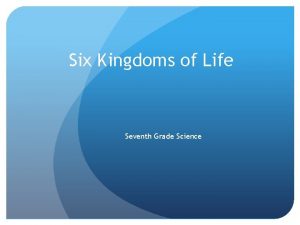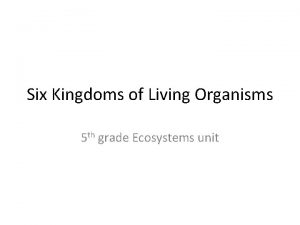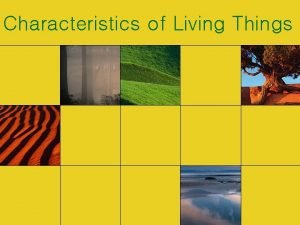THE SIX KINGDOMS OF LIVING THINGS Part 1



















![Halophiles – live in very salty water [halite is rock salt] (Dead Sea) (evaporation Halophiles – live in very salty water [halite is rock salt] (Dead Sea) (evaporation](https://slidetodoc.com/presentation_image/37eb4d61aeee2ebea6ed95c0956fbe1f/image-20.jpg)
















![Three types: • [1] Spheres (cocci) Three types: • [1] Spheres (cocci)](https://slidetodoc.com/presentation_image/37eb4d61aeee2ebea6ed95c0956fbe1f/image-37.jpg)




![• [2] Rods (bacilli) • [2] Rods (bacilli)](https://slidetodoc.com/presentation_image/37eb4d61aeee2ebea6ed95c0956fbe1f/image-42.jpg)







![• [3] Spirals (spirilli) • [3] Spirals (spirilli)](https://slidetodoc.com/presentation_image/37eb4d61aeee2ebea6ed95c0956fbe1f/image-50.jpg)



















- Slides: 69

THE SIX KINGDOMS OF LIVING THINGS

Part 1 • Archaebacteria • Eubacteria • Protista

PROKARYOTES & EUKARYOTES

PROKARYOTES • Archaebacteria (prokaryotes “Without nucleus”) • Lack any internal membrane-bound structures • Smallest single-celled organisms on Earth

EUKARYOTES • “True nucleus” • Found in all living things except bacteria • Have many kinds of internal membranebound structures • Have a nucleus where DNA is located

(1) Archaebacteria • • • “Archae” = “Ancient” (≥ 3 b. y. ) Prokaryotes (“before nucleus”) Small, single-celled Live where other living things cannot Need no oxygen or sunlight Make food from chemosynthesis, other chemicals, such as H 2 S

Different groups: • Methanogens – make methane

Methanogens: methane-producing bacteria

Methanopyrus

Methosarcina

Thermophiles – live in very hot water (hot springs) (underwater geothermal vents)


Thermus aquaticus Yellowstone N. P.



Underwater geothermal vents (“black smokers”) discovered - 1976


Ecology of deep thermal vents • Hot, mineral-rich water spews out • Mixes with cold ocean water • Supplies energy, raw materials

![Halophiles live in very salty water halite is rock salt Dead Sea evaporation Halophiles – live in very salty water [halite is rock salt] (Dead Sea) (evaporation](https://slidetodoc.com/presentation_image/37eb4d61aeee2ebea6ed95c0956fbe1f/image-20.jpg)
Halophiles – live in very salty water [halite is rock salt] (Dead Sea) (evaporation ponds)





Great Salt Lake – halophiles turn the land red after floods

Acidophiles – live in highly acid water (acid lakes)




Alkalaiphiles – live in highly alkaline water (Mono Lake, California) (Lake Eyre, Australia)




Cyanobacteria • Earliest photosynthesizers • Changed Earth’s early atmosphere from reducing to oxidizing Stromatolites Shark’s Bay Australia

(2) Eubacteria (“true” bacteria) • Live in soil, water, human bodies • Germs – harmful (cause sickness, diseases) • Beneficial bacteria – a. used to make yogurt, cheese, etc. • • • Typically 40 million/gram soil 1 million/m. L fresh water 5 x 1030 bacteria on Earth Form much of Earth’s biomass. Approx. 10 x as many bacteria as human cells in the body.

![Three types 1 Spheres cocci Three types: • [1] Spheres (cocci)](https://slidetodoc.com/presentation_image/37eb4d61aeee2ebea6ed95c0956fbe1f/image-37.jpg)
Three types: • [1] Spheres (cocci)

Staphylococcus epidermidis

Methicillin-resistant Staphylococcus aureus (MRSA)

Meningitis

Pneumonia
![2 Rods bacilli • [2] Rods (bacilli)](https://slidetodoc.com/presentation_image/37eb4d61aeee2ebea6ed95c0956fbe1f/image-42.jpg)
• [2] Rods (bacilli)

Escherichia coli

Bubonic Plague

Tuberculosis

Anthrax

Tetanus

Typhoid Fever

Ulcers
![3 Spirals spirilli • [3] Spirals (spirilli)](https://slidetodoc.com/presentation_image/37eb4d61aeee2ebea6ed95c0956fbe1f/image-50.jpg)
• [3] Spirals (spirilli)

Syphilis

Lyme Disease


Leptospirosis (200 x)

• First described by Adolf Weil in 1886 • “Acute infectious disease with enlargement of spleen, jaundice and nephritis". • First observed in 1907 from a post-mortem renal tissue slice. 1908 – Inada and Ito first identified it as the causative organism; 1916 – noted its presence in rats. • World's most common disease transmitted to people from animals • Rare in humans. • Commonly transmitted to humans by allowing water that has been contaminated by animal urine to come in contact with unhealed breaks in skin, eyes, or mucous membranes.

Useful bacteria • Bacterial fermentation of milk → yogurt • Bacteria, enzymes turn milk into cheese • Lactic acid bacteria turn cabbage into sauerkraut • Bacterial fermentation turns cucumbers into pickles • Bacteria turn alcohol in wine into vinegar.

• Other foods made by bacteria: – Sourdough breads, pretzels – Olives – Soy sauce

(3) Protista • Protozoans – animal-like – Flagellates – Amoeboids – Ciliates – Sporozoans • Plantlike • Fungus-like – Slime molds, water molds

Protozoans - flagellates Giardia lamblia

Termite protozoan

Protozoans - amoeboids

Protozoans - ciliates


Plantlike protozoans Euglena

Plant-like Protists • Algae • Kelp

Fungus-like Protists • Slime molds



 What are the six kingdoms of classification
What are the six kingdoms of classification Kingdoms of living things
Kingdoms of living things Examples of the 6 kingdoms
Examples of the 6 kingdoms Five kingdoms of living things
Five kingdoms of living things Is protoctista autotrophic or heterotrophic
Is protoctista autotrophic or heterotrophic Difference between living and non living organisms
Difference between living and non living organisms The smallest living unit within the human body is
The smallest living unit within the human body is 6 characteristics of living things
6 characteristics of living things Six characteristics of living things
Six characteristics of living things List the six characteristics of living things
List the six characteristics of living things Seven processes of living things
Seven processes of living things Dichotomous key for 6 kingdoms
Dichotomous key for 6 kingdoms Are archaebacteria autotrophs
Are archaebacteria autotrophs Classification of pathogens
Classification of pathogens How do scientists classify protists
How do scientists classify protists What are the three domains and six kingdoms?
What are the three domains and six kingdoms? Cladogram of 6 kingdoms
Cladogram of 6 kingdoms What are the six kingdoms of life?
What are the six kingdoms of life? Characteristics of animals as living things
Characteristics of animals as living things Common characteristics of the six kingdoms of life
Common characteristics of the six kingdoms of life Characteristics of the six kingdoms
Characteristics of the six kingdoms Is moss living or non-living
Is moss living or non-living Living non living dead
Living non living dead A polygon with six congruent sides and six congruent angles
A polygon with six congruent sides and six congruent angles Why is water important to living things
Why is water important to living things Freshwater non living things
Freshwater non living things Living things grow
Living things grow Living things meaning
Living things meaning Ecosystem living and nonliving things
Ecosystem living and nonliving things These are organic compounds made by living things
These are organic compounds made by living things Living things grow images
Living things grow images Linnaeus
Linnaeus Living things 20
Living things 20 How many links are there in a food chain
How many links are there in a food chain Food chain and web
Food chain and web 5 kingdoms of life
5 kingdoms of life Limiting factor in ecosystem
Limiting factor in ecosystem Gets its energy from eating living things
Gets its energy from eating living things Archaea kingdom
Archaea kingdom A genus is subdivided into smaller groups called
A genus is subdivided into smaller groups called Why do we classify living things
Why do we classify living things Hetertrophs
Hetertrophs Categories of living things
Categories of living things 5 groups of living things
5 groups of living things Domain of living things
Domain of living things What are the 7 classifications of living things
What are the 7 classifications of living things Thampi torrent frog
Thampi torrent frog How living things are organized
How living things are organized Structural adaptations examples
Structural adaptations examples Chapter 7 the evolution of living things answers
Chapter 7 the evolution of living things answers Categories of living things
Categories of living things Living things 20
Living things 20 Kingdom phylum class order
Kingdom phylum class order Living things grow and change
Living things grow and change Tissue are grouped together to form various
Tissue are grouped together to form various What are abiotic factors in an ecosystem
What are abiotic factors in an ecosystem Non living things outside
Non living things outside 5 groups of living things
5 groups of living things 7 characteristics of living things
7 characteristics of living things How does plant move
How does plant move How are living things named
How are living things named What is characteristic of living things
What is characteristic of living things What part of the plant carries and protects the seed
What part of the plant carries and protects the seed Nature of life science
Nature of life science Movement characteristics of living things
Movement characteristics of living things Classifying living things lesson 1 answer key
Classifying living things lesson 1 answer key Geosphere
Geosphere Domain kingdom phylum class
Domain kingdom phylum class Life cycle of all living things
Life cycle of all living things How are enzymes important to living things
How are enzymes important to living things

